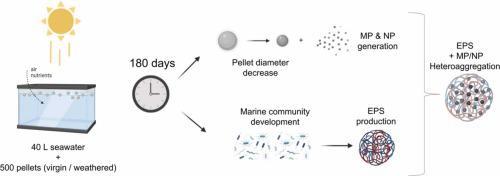Journal of Hazardous Materials ( IF 12.2 ) Pub Date : 2023-05-30 , DOI: 10.1016/j.jhazmat.2023.131710 Katerina Karkanorachaki 1 , Evdokia Syranidou 1 , Pagona-Noni Maravelaki 2 , Nicolas Kalogerakis 3

|
The accumulation of plastic waste in the oceans has caused growing concern for its effects on marine life. The interactions of plastics with environmental factors have been linked to fragmentation to micro- and nanoparticles with different properties and consequences, but the mechanism of fragmentation has not been fully understood yet. In this work, we investigate the combined effect of marine communities and ultraviolet (UV) radiation towards the degradation of virgin and artificially weathered polypropylene (PP) pellets after a long-term incubation period in marine mesocosms. The surface chemical alterations and deterioration of the polymer, in conjunction with the attachment and evolution of marine bacterial communities, the development of biofilm and exopolymeric substances (EPS), as well as the colloidal properties (zeta-potential and hydrodynamic diameter) of the mesocosms were studied. The surface area of both types of pellets decreased over time, despite no concrete weight change being observed. Cell growth, EPS production and colloid particle size were correlated to the loss of area. Therefore, we propose that surface area could be effectively monitored, instead of weight loss, as an alternative indicator of polymer degradation in biodegradation experiments. Changes in the chemical structure of the polymer, in addition to the evolution of the biological factors, implied that a complex degradation process alternated between two phases: an abiotic phase, when UV irradiation contributes to the deterioration of the polymer surface layers and a biotic phase, when marine communities degrade the weathered polymer surface to reveal the underlying layer of virgin polymer. Finally, microscopic particles, produced as a result of the decrease in pellet area, promoted the aggregation of colloidal particles. The role and impacts of these colloidal particles in marine ecosystems are yet as unidentified as that of micro- and nano-sized plastic particles and call for further investigation.
中文翻译:

海洋中生态系统中聚丙烯颗粒相互交织的协同非生物和生物降解
海洋中塑料废物的积累引起了人们对其对海洋生物影响的日益关注。塑料与环境因素的相互作用与具有不同性质和后果的微米颗粒和纳米颗粒的碎裂有关,但碎裂的机制尚未完全了解。在这项工作中,我们研究了海洋群落和紫外线 (UV) 辐射对原始和人工风化聚丙烯 (PP) 颗粒在海洋中环境中长期培育后降解的综合影响。聚合物的表面化学变化和退化,以及海洋细菌群落的附着和进化、生物膜和胞外聚合物物质(EPS)的发展,以及介观体系的胶体特性(zeta 电位和流体动力学直径)也进行了研究。尽管没有观察到混凝土重量变化,但这两种颗粒的表面积随着时间的推移而减少。细胞生长、EPS 产生和胶体颗粒大小与面积损失相关。因此,我们建议可以有效地监测表面积,而不是重量损失,作为生物降解实验中聚合物降解的替代指标。除了生物因素的演变之外,聚合物化学结构的变化意味着复杂的降解过程在两个阶段之间交替:非生物阶段,此时紫外线照射导致聚合物表面层的恶化;以及生物阶段, 当海洋群落降解风化的聚合物表面,露出下面的原始聚合物层时。最后,由于颗粒面积减少而产生的微观颗粒促进了胶体颗粒的聚集。这些胶体颗粒在海洋生态系统中的作用和影响与微米和纳米尺寸的塑料颗粒一样尚不清楚,需要进一步研究。











































 京公网安备 11010802027423号
京公网安备 11010802027423号